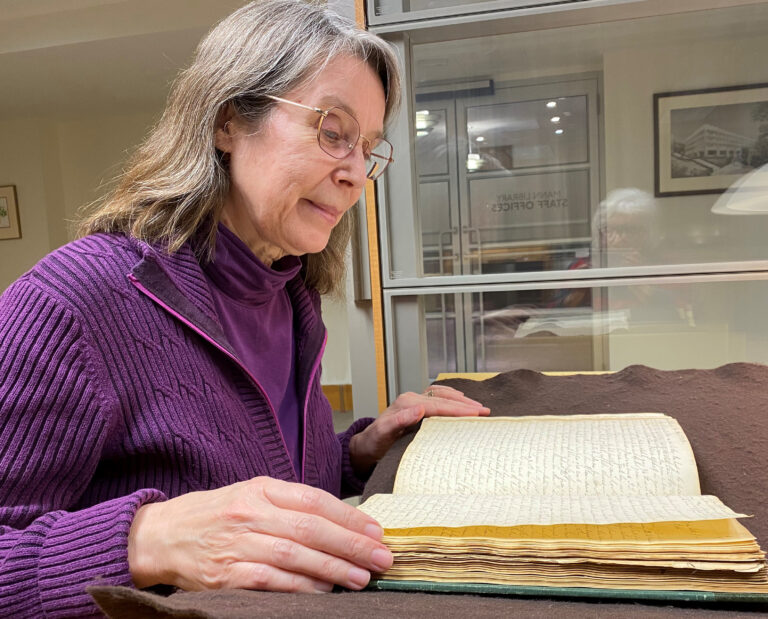December 25th, Christmas Day, is widely known as a day for sharing and giving. It also happens to be the birthday of a man known as the father of American beekeeping: Lorenzo Langstroth, born Philadelphia, Pennsylvania in 1810. With the winter holidays just behind us, it seems fitting to have this particular coincidence in mind as we announce a resource that we’re pretty sure students of beekeeping and its history will find a wonderful gift: a fully digitized, searchable copy of Langstroth’s handwritten personal journal. Where a researcher would have once had to make an in-person trip to Mann’s special collections reading room to attempt a deciphering of Langstroth’s (infamously difficult to read!) handwriting, the journal is now freely available—and actually readable—as both a digitized version of the original work and in a transcribed form as part of the online Biodiversity Heritage Library.
For those not yet fully in the know, Lorenzo Langstroth looms large in American beekeeping history thanks to discoveries and inventions he made as a self-taught apiarist, innovations which essentially revolutionized the 19th century practice of beekeeping and facilitated its development into the profitable industry of today. His guide on beekeeping, The Hive and the Honeybee, was first published in 1853 and has remained continuously in print since then. Langstroth’s story is also poignantly notable for a reason that you don’t have to a be a beekeeper to appreciate deeply: his struggles with debilitating depression, which stymied many of his professional endeavors. While working intermittently as a pastor and teacher when his mental health allowed, Langstroth found constant, life-affirming inspiration in the bee world he observed closely through the prism of the hives he kept for most of his adult life.
The journal Langstroth kept is a treasure for several reasons. It provides fascinating insight into pivotal moments of beekeeping’s technological history. It is, as well, an intimate view of resilience in the face of sometimes devastating mental health challenges. And last but really not least, in the comments and pet peeves that Langstroth also recorded in his ongoing notes-to-self, his off-the-record writing offers a more mundane but no less instructive tour through the day-to-day concerns—from keeping bee hives productive to the vexing challenges of protecting trade secrets and securing patents for promising new discoveries in a timely way—that would have been top-of-mind for any aspiring agricultural entrepreneur of the 19th century.
The online availability of Langstroth’s journal in both its handwritten and transcribed form has been a work very long in the making. When early 20th century entomologist Everett Franklin Phillipps joined the Cornell faculty 1924, he made it his mission to establish one of the world’s most important collections of beekeeping materials—now known as the E. F. Phillips Collection at Mann Library. Recognizing the importance of what is arguably the collection’s crown jewel—the original Langstroth journal—for the beekeeping field, Phillips began the painstaking process of transcribing 600 pages of Langstroth’s cramped, highly slanted script—rendered even more illegible by the frequent ink bleed-through from other pages—into easily readable typescript. The project remained unfinished at the time of Phillips passing in 1951, and others took up the work intermittently over the following decades. But it wasn’t until the epic pandemic-era national lockdown of 2020 that intrepid Mann Library collections specialist Betsy Elswit finally found herself with the time needed to finish transcribing of the journal’s final 200 pages along with also reviewing, correcting and digitally reformatting all previous transcriptions. Thanks to this heroic work, a browse through the work on the Biodiversity Diversity Heritage Library today provides a look at Langstroth’s original writing with a side-by-side, fully-aligned view of the corresponding transcribed, machine-readable text.
There is much to appreciate in Reverend Lorenzo Langstroth’s courageous perseverance through the inspirational highs and deep lows of life to impact the practice of beekeeping so profoundly. Future generations of beekeepers and other readers are also likely to find themselves deeply grateful to him for the rich and authentic record of both remarkable scientific observation and personal journey he left with us—and to Ms. Elswit for her invaluable part in bringing this record to the world’s fingertips.

